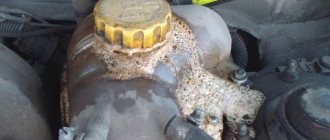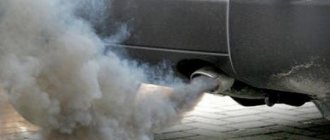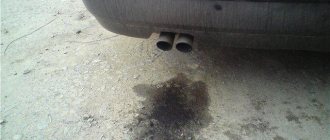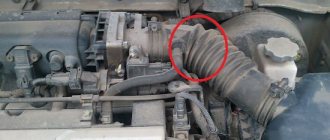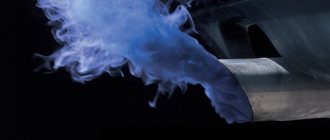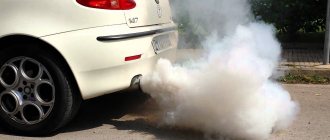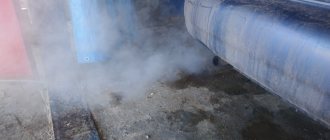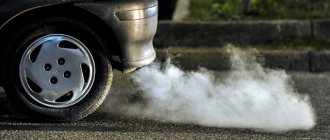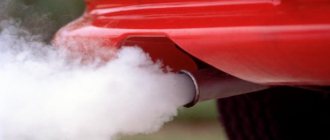Blue or gray smoke from the exhaust pipe indicates combustion of engine oil in the cylinders. Among the reasons for the appearance of bluish smoke are wear of the cylinder-piston group, insufficient cylinder sealing in the area of the piston rings, hardening of the valve stem seals and turbine malfunction. Each breakdown has a number of signs that simplify diagnosis and help identify faults by the color of the exhaust of a gasoline/diesel engine.
Blue smoke: causes of increased oil consumption
Blue smoke from the exhaust pipe is always accompanied by increased oil consumption. The main reasons for high engine lubricant consumption:
- Worn valve stem seal and valve guides. Valve seals prevent oil from entering the valve stem from the cylinder head cavity into the engine combustion chamber;
- large clearance of turbocharger plain bearings. Since proper sealing of the shaft is impossible due to the large gap, the oil is sucked into the intake tract and burns in the cylinders with a fresh charge of the fuel mixture. It is also possible for oil to enter the exhaust tract, where it will burn off the hot parts of the exhaust system, producing smoke with a bluish tint;
- clogged oil return line from the turbocharger. The malfunction occurs when maintenance intervals are not observed or low-quality engine oil is used. Since lubricant is supplied to the turbine under pressure, resistance to draining excess oil back into the sump leads to lubricant entering the intake tract through the plain bearings;
- high pressure of crankcase gases. Excessive pressure in the engine sump creates air pressure, which prevents the piston rings from removing excess oil. As a result, too much lubricant remains on the surface of the cylinders, which burns and causes thick blue smoke from the exhaust pipe;
- leakage of the joint between the cylinder block and the cylinder head. Oil enters the combustion chamber through areas of weakening of the cylinder head gasket to the cylinder block. If the leak is not limited to oil, and antifreeze also gets into the cylinders, blue-white smoke will come out of the exhaust pipe;
- a consequence of engine repair in violation of the technology of processing, boring, honing and liner of the cylinder block. To create an oil film of the correct thickness (1-3 microns), it is important not only to maintain the geometry of the cylinders, but also to maintain the degree of surface roughness;
- malfunction of the cylinder-piston group (CPG).
Why does a gasoline engine smoke?
When you see a smoking car on the road, you can confidently say that there are problems with its engine. If it is in good condition, the exhaust will be transparent, since it does not contain any coloring substances. What do gasoline engine exhaust gases consist of?
95% of their volume consists of nitrogen, oxygen, as well as gaseous products of gasoline combustion: nitrogen oxides, carbon oxides and hydrocarbon radicals. All these substances are colorless, so the human eye cannot detect them. Finally, from 3 to 5% of the exhaust is water vapor, which is a product of pyrolysis (thermal decomposition) of gasoline molecules.
It remains to be assumed that smoke from the muffler pipe appears when some foreign substances other than gasoline are burned in the engine cylinders. And indeed it is. A gasoline engine uses some auxiliary materials during operation. Liquid motor oil is used to lubricate parts, and coolant (antifreeze or antifreeze) is used to cool the cylinders.
For a number of reasons, these liquids can enter the cylinders, where they mix with fuel. The products of their combustion give color to the exhaust gases - the engine begins to smoke. Moreover, the escaping smoke can have different colors and shades. They can be divided into three groups: white, blue and black smoke. An experienced mechanic can determine the cause of the malfunction by the nature of the smoke.
Blue smoke appears only when cold
The appearance of blue smoke from the exhaust pipe after the car has been parked for a long time indicates wear of the valve stem seals. With constant temperature changes, rubber products lose their elasticity. At high mileage, wear of the valve sleeve and stem leads to valve runout. Due to the loss of elasticity, the compression force on the rod decreases, so a gap appears between the valve stem and the cap, through which the oil flows into the combustion chamber. During long-term parking, lubricant accumulates in the cylinders, which actively burns out after starting. It is typical that after 3-5 minutes of warming up the engine, the blue smoke may practically disappear.
You can check the valve seals without disassembling the cylinder head using an endoscope with a rotating camera. Looking into the cylinders after a long period of parking, you can see fresh drops of oil flowing onto the piston through the valve rod. On many cars, with the valve cover removed, you can visually assess the fit of the caps and the integrity of the compression spring. You can check the elasticity of the rubber only after dismantling the seals. If you have never dealt with engine repairs and do not have experience checking the caps, the best diagnosis is to compare the elasticity of the old and new oil seals (just try to compress them one by one).
Black smoke coming out
The greatest damage to the environment is caused by clouds of black smoke coming out of a car's exhaust pipe or directly from the power unit. The most likely reasons for the appearance of such smoke lie in the following violations:
- malfunctions of the engine control system;
- disorder of adjustments in fuel equipment;
- reducing engine cylinder compression.
An imbalance between the number of components of the air-fuel mixture in the direction of increasing fuel causes not only the formation of black smoke, but also significantly increases fuel consumption. Failure of the normal mixture formation process may be caused by contamination of the air filter. A deficiency of air entails an excess of fuel when preparing the air-fuel mixture.
A decrease in the compression level can be caused by mechanical damage to the cylinders, which significantly reduces the power of the power unit and contributes to an increase in the concentration of fuel in the mixture.
To carry out accelerated diagnostics, it is necessary to examine the condition of the spark plugs. Black deposits indicate that there is a need to replace spark plugs with new samples, followed by repair of deformed elements and regulation of power unit systems.
CPG condition
When the valve seals have been replaced, the turbine and crankcase ventilation system have been checked, and the blue smoke from the exhaust system has not disappeared, pay attention to the condition of the cylinder-piston group. Most likely, there is too much clearance between the piston and cylinder. This happens either due to the fact that the piston rings are stuck/worn out and do not perform their functions, or due to wear at the point of contact of the piston skirt with the cylinder. Both types of malfunction are only consequences caused by high mileage, unqualified repairs or non-compliance with service intervals.
In a 4-stroke internal combustion engine, piston rings perform the following functions:
- seal against exhaust gases breaking into the crankcase. On modern cars, a high degree of sealing is achieved by using two compression rings;
- removal and distribution of oil. The rings should not only distribute the lubricant evenly throughout the cylinder, but also regulate the thickness of the oil film;
The main volume of excess lubricant is removed by the oil scraper ring (3rd in a row), as well as by the second combined compression ring.
- heat removal from the piston. About 70% of the heat absorbed by the piston is removed through the piston rings (55% of the total volume falls on the 1st compression ring, 30% on the 2nd compression ring and 15% on the oil scraper ring).
The influence of the quality of the oil used on smoke formation
Motor oil must have certain characteristics. The quality of the lubricant used directly depends on its properties. If the car engine contains low-quality oil, the viscosity coefficient of which does not correspond to the car brand, or if the temperature inside the engine increases, a sharp loss of useful properties of the lubricant occurs, this leads to serious damage to the elements and systems of the power unit. If blue smoke appears, you need to check the oil for compliance and, if necessary, completely replace it.
The appearance of smoke can be caused by a number of other reasons - from the appearance of microcracks in the engine body to the use of the wrong type of fuel intended for a given engine brand. Each specific situation always has a solution when seeking help from qualified specialists.
Source
Why don't piston rings work?
Reasons for ring failure:
- loss of elasticity and resilience due to overheating or a large number of heating/cooling cycles (natural metal fatigue, which occurs over long runs);
- coked piston rings. The rings stick if varnish deposits and carbon deposits form inside the piston grooves. If the compression rings stick in the cylinders, compression decreases, the thermal load on the oil scraper ring increases, and the crankcase gas pressure increases. At high mileage, the car emits blue smoke due to coking of the oil scraper rings. In some cases, a malfunction occurs after the car has been left idle for a long time, low-quality engine oil has been used, and maintenance intervals have been ignored;
- insufficient thermal gap. As thermal expansion occurs, the rings put excessive pressure on the cylinder, causing them to overheat, wear out faster, and create scuffing on the cylinder walls;
- piston movement is skewed. Misalignment as a result of bending of the connecting rod leads to a rocking movement of the piston in the longitudinal axis of the engine, which is why scuff marks appear on the cylinder walls and piston skirts, and the piston rings take on an elliptical shape;
- violation of the geometric shape of the cylinder. Occurs due to coked piston rings, skewed piston movement or unskilled repairs (poor-quality boring/liner of the cylinder block, non-compliance with the sequence and tightening torque of the cylinder head bolts);
- errors in troubleshooting engine parts during major repairs. For example, installing new pistons and rings into cylinders with worn tops causes the rings to hit the shoulder, vibrate, wear out quickly, and no longer seal properly. Similar symptoms occur when the pistons barely noticeably hit the cylinder head, which is caused by an incorrect protrusion of the pistons or a small thickness of the cylinder head gasket. New piston rings cannot be installed if the cylinder has an elliptical bore;
- Incorrectly installed or selected piston rings. Excessive tension with unqualified installation will soon result in bluish smoke during gas changes and increased oil consumption.
Smoke from under the hood when starting the engine
This phenomenon can most often be encountered if there is an oil leak in any place (seals, gaskets). The lubricant enters the exhaust manifold and begins to burn out as the engine warms up, and the driver sees smoke from the engine compartment.
Also, one should not exclude the possibility of foreign objects getting onto the heated elements of the internal combustion engine or the exhaust system. A similar effect can be caused by a fuel leak, which occurs due to the loss of tightness of certain elements of the fuel supply and fuel injection system.
In both cases, the problem must be resolved immediately, as the risk of fire and fire in the engine compartment increases significantly. At the same time, leaks in the exhaust system or problems with turbocharging can also be the reason why smoke appears from under the hood when starting the engine or smokes constantly while it is running.
For example, a bent exhaust pipe flange or a burnt gasket will cause smoke to appear in the engine compartment. You should also pay attention to whether the car has a liquid preheater for the interior and engine.
The appearance of smoke from under the hood in this case is more typical of diesel units, since pre-heating is more in demand on this type of engine. To put it simply, the heater on a particular car can be an autonomous chamber for burning fuel (Webasto, etc.).
Since the device burns fuel inside itself, an air supply is required to burn a portion of the fuel, and a system must be implemented to remove gases after combustion. In case of unqualified self-installation or for other reasons, the gas exhaust system from the heater can be removed so that the exhaust pipe goes into the engine compartment.
Normally, pre-start liquid heaters practically do not smoke, and combustion products are discharged in the area of the front fender (behind the wheel). At the same time, certain malfunctions may well lead to smoke appearing from under the hood. In this case, the installed system should be checked separately.
How does detonation and poor mixture composition ruin your engine?
Detonation combustion not only leads to shock loads on the partitions, piston crown, and valves, but also tears off the oil film from the cylinder walls and provokes rattling of the piston rings. The consequences of glow ignition are similar, in which the fuel mixture is ignited not by a spark, but by contact with a hot spark plug.
Detonation is the explosive combustion of a mixture with high peak pressure in the combustion chamber.
Overflowing fuel injectors also lead to the breakdown of the oil film. Scouring on the cylinder walls is a natural consequence of dry friction of the piston against the cylinder.
How to understand the reason
Devices with a carburetor injection system generate black smoke as a result of fuel overflowing into the float chamber. You will have to diagnose the condition of the air supply jets and needle valve and, if necessary, replace them.
Injection systems suffer from over-enrichment of the mixture due to incorrect operation of the sensors. The injectors themselves tend to lose their tightness. As a result of overflow, the combustion chamber is oversaturated with fuel, which causes the cylinder walls to become dry - the lubricant burns out.
To initially determine the cause, you do not need to go to the market for special equipment. All you need is a compression gauge. The sequence of actions is as follows.
- Unscrewing the spark plugs from the cylinder head.
- Engaging the handbrake.
- Transferring the box to neutral mode.
- Install the compression gauge head with a certain force so that it fits into the hole where the spark plug is screwed.
- Crank the crankshaft with the starter for two to three seconds.
- If the value is small, re-check with preliminary addition of 25 grams of oil.
By the increase in compression after adding oil, you can understand that the piston rings need to be replaced, as they are badly worn.
Malfunction of the crankcase ventilation system
Symptoms of a faulty VCG system:
- The engine emits blue smoke.
- Oil fogging is observed near the valve cover, oil pan, timing chain cover, oil filler neck, crankshaft and camshaft seals.
- Increased oil consumption.
- Oil deposits in the intake tract.
Due to the backpressure of exhaust gases after draining the oil from the turbocharger, a large amount of oil can accumulate in the “cold” part pipe and the intercooler. In this case, it is easy to make the mistake of sending the turbine for repair or replacing it with a new one. The root cause of oil deposits and blue exhaust may be low VCG flow capacity or a faulty PCV valve.
The nature of smoke and the degree of wear of the power unit
Experienced specialists, based on their own observations or the client’s descriptions of the characteristics of smoke, can with a high degree of probability guess the nature of the problem. Let's look at a few common cases :
- If the blue-white exhaust appears only when the engine warms up and gradually disappears as it warms up, then there is no reason to fear serious wear of the mechanisms. This effect is explained by the ability of parts to expand; when heated, the gaps decrease and oil leakage stops.
- In the case when, after warming up the power unit, smoking not only continues, but also intensifies, it can be argued that there is significant wear of the internal combustion engine elements. The reason is the following - the expansion is not enough to reliably seal the gaps and through them hot oil easily penetrates into the cylinders.
It goes without saying that blue or blue-white smoke from the muffler is accompanied by increased oil consumption. Therefore, monitoring its level using a dipstick is a necessary operation, which makes it possible to determine a breakdown in the early stages of its occurrence. Exceeding the consumption rate of lubricants should immediately alert the owner. In addition, on modern cars, due to the fact that they are equipped with a neutralizer that can purify gases, it is not always possible to determine the color of the exhaust even with increased oil consumption.
We must not forget about such a phenomenon as compression, the degree of which can sometimes be misleading. So, at first glance, wear of the CPG elements is quite often characterized by loss of compression and increased crankcase gas pressure. However, at the same time, a significant amount of oil seals the gaps and if they are not very far from standard, then the compression gauge readings may be normal, and sometimes closer to the upper limit.

